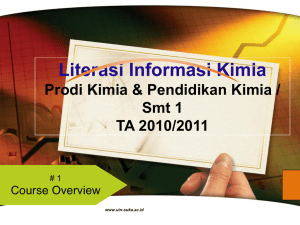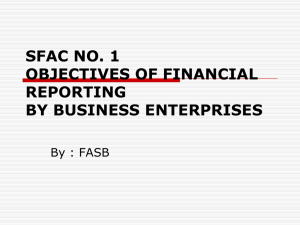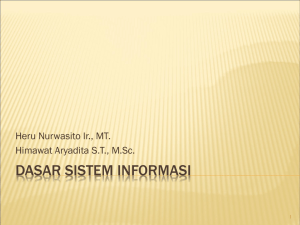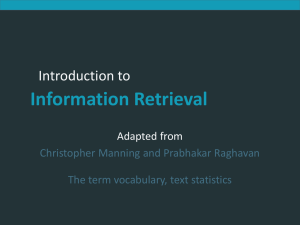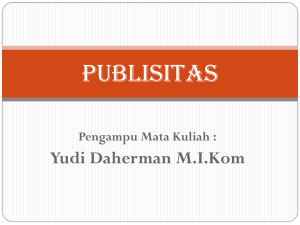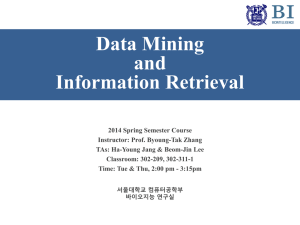Tokenisasi - Informatika
advertisement
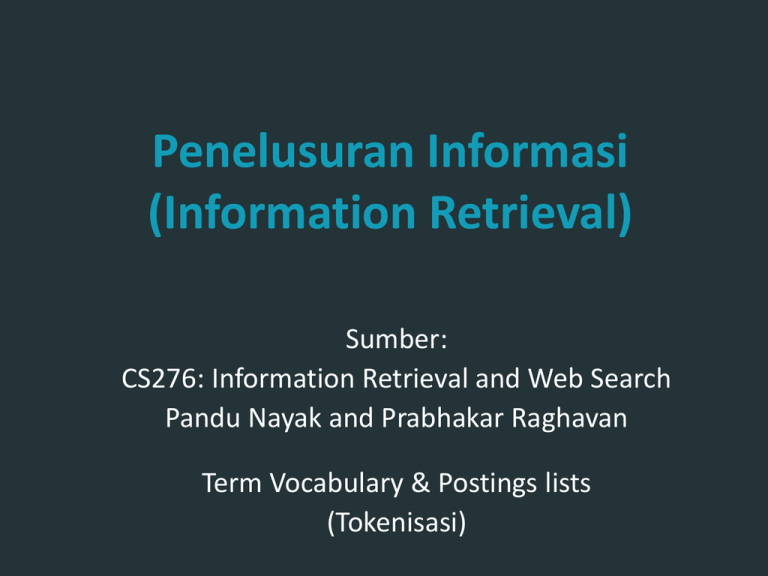
Penelusuran Informasi (Information Retrieval) Sumber: CS276: Information Retrieval and Web Search Pandu Nayak and Prabhakar Raghavan Term Vocabulary & Postings lists (Tokenisasi) Penelusuran Informasi (Information Retrieval) Ch. 1 Pertemuan sebelumnya: Struktur dari Inverted Indeks: Dictionary (Vocabulary) & Inverted List (Postings) Vocabulary urut berdasarkan term (kata) Untuk memproses Boolean Query: Melakukan interseksi (merging) secara linear 2 Penelusuran Informasi (Information Retrieval) Topik Pada Pertemuan Ini Tahapan dalam Membangun Indeks Preprocessing untuk membentuk vocabulary Documen Tokenisasi (tokenization) Kata (terms) apa saja yang dimasukkan dalam indeks Inverted List (Postings) Cara merge secara lebih cepat (faster merge) dengan cara skip lists Query dalam bentuk kaliman (phrase) 3 Introduction to Information Retrieval Diagram Proses Indexing Dokumen Friends, Romans, countrymen. Tokenizer Token stream Friends Romans Countrymen Linguistic module Modified tokens Inverted index friend roman countryman Indexer friend 2 4 roman 1 2 countryman 13 4 16 Penelusuran Informasi (Information Retrieval) Parsing Dokumen Perhatikan terlebih dahulu format dokumen pdf/word/excel/html ? Ditulis dalam bahasa apa? Format character set yang digunakan Bagaimana menentukan jawaban dari pertanyaan di atas? Observasi secara manual? Atau dilakukan secara otomatis menggunakan metode klasifikasi? 5 Penelusuran Informasi (Information Retrieval) Sec. 2.1 Complications: Format/Language Dokumen yang akan diindeks dapat berupa dokumen yang ditulis dalam beberapa bahasa Sebuah indeks dapat mengandung kata dari beberapa bahasa Karena sebuah dokumen dapat ditulis dalam beberapa bahasa Contoh: Email dalam bahasa Inggris tetapi attacment dari email adalah dokumen yang ditulis dalam bahasa Jerman Apakah unit dari sebuah dokumen? Sebuah file? Sebuah email? Sebuah email dengan 5 attachments? Sekumpulan files (PPT atau halaman HTML)? 6 Introduction to Information Retrieval TOKENS & TERMS (KATA) 7 Penelusuran Informasi (Information Retrieval) Sec. 2.2.1 Tokenisasi (Tokenization) Input: “Friends, Romans, Countrymen” Output: Tokens Friends Romans Countrymen Jadi token adalah sederetan karakter (a sequence of characters) dalam dokumen Setiap token menjadi kandidat dari elemen dalam indeks, tentunya setelah preprocessing 8 Penelusuran Informasi (Information Retrieval) Sec. 2.2.1 Tokenisasi (Tokenization) Beberapa isu dalam tokenisasi: Finland’s capital Finland? Finlands? Finland’s? Hewlett-Packard Hewlett dan Packard sebagai dua token atau satu? state-of-the-art: break up hyphenated sequence co-education lowercase, lower-case, lower case? San Francisco: satu token atau dua? Bagaimana cara memutuskan bahwa SF adalah satu token? 9 Penelusuran Informasi (Information Retrieval) Sec. 2.2.1 Angka (Numbers) 3/12/91 Mar. 12, 1991 12/3/91 No. B-52 Kode: 324a3df234cb23e Telepon: (0651) 234-2333 Biasanya angka memiliki space diantaranya Sistem IR yang lama tidak mengindeks angka Tapi angka itu penting. Coba bayangkan bila ingin mencari baris dari error kode program melalui Sistem IR atau mencari nomor tertentu Salah satu solusi adalah menggunakan mekanisme n-grams 10 Penelusuran Informasi (Information Retrieval) Sec. 2.2.1 Tokenisasi: Isu dalam bahasa French L'ensemble satu token atau dua? L ? L’ ? Le ? Want l’ensemble to match with un ensemble Sampai tahun 2003, tidak berhasil bila dicari via Google Internationalization! German noun compounds are not segmented Lebensversicherungsgesellschaftsangestellter ‘life insurance company employee’ German retrieval systems benefit greatly from a compound splitter module Can give a 15% performance boost for German 11 Sec. 2.2.1 Penelusuran Informasi (Information Retrieval) Tokenisasi: Isu dalam bahasa Chinese and Japanese: 莎拉波娃现在居住在美国东南部的佛罗里达。 Not always guaranteed a unique tokenization Further complicated in Japanese: Dates/amounts in multiple formats フォーチュン500社は情報不足のため時間あた$500K(約6,000万円) Katakana Hiragana Kanji Romaji 12 Penelusuran Informasi (Information Retrieval) Sec. 2.2.1 Tokenisasi: Isu dalam bahasa Tulisan Arab ditulis dari kanan ke kiri tetapi untuk angka dibaca dari kiri ke kanan Words are separated, but letter forms within a word form complex ligatures ← → ←→ ← start ‘Algeria achieved its independence in 1962 after 132 years of French occupation.’ 13 Penelusuran Informasi (Information Retrieval) Sec. 2.2.2 Stop words Menggunakan stop list, kata-kata yang sering muncul (tetapi kurang penting) dapat dikeluarkan dari indeks: Secara semantic mereka tidak penting: the, a, and, to, be Jumlahnya cukup banyak: ~30% dari semua kata dalam corpus Trend: stopword tidak diikutkan: Hemat indeks dan dapat memperkecil ukuran indeks walaupun dikompres Query optimisasi menjadi lebih baik Tapi perlu juga memperhatikan Query sbb: Judul film: “King of Denmark” Judul Lagu: “Let it be”, “To be or not to be” Relational query: “flights to London” 14 Penelusuran Informasi (Information Retrieval) Sec. 2.2.3 Normalisasi Kata (terms) Kata harus dinormalisasidalam in indexed text as well as query words into the same form We want to match U.S.A. and USA Result is terms: a term is a (normalized) word type, which is an entry in our IR system dictionary We most commonly implicitly define equivalence classes of terms by, e.g., deleting periods to form a term U.S.A., USA USA deleting hyphens to form a term anti-discriminatory, antidiscriminatory antidiscriminatory 15 Penelusuran Informasi (Information Retrieval) Sec. 2.2.3 Normalization: other languages Accents: e.g., French résumé vs. resume. Umlauts: e.g., German: Tuebingen vs. Tübingen Should be equivalent Most important criterion: How are your users like to write their queries for these words? Even in languages that standardly have accents, users often may not type them Often best to normalize to a de-accented term Tuebingen, Tübingen, Tubingen Tubingen 16 Sec. 2.2.3 Penelusuran Informasi (Information Retrieval) Normalization: other languages Normalization of things like date forms 7月30日 vs. 7/30 Japanese use of kana vs. Chinese characters Tokenization and normalization may depend on the language and so is intertwined with language detection Morgen will ich in MIT … Is this German “mit”? Crucial: Need to “normalize” indexed text as well as query terms into the same form 17 Penelusuran Informasi (Information Retrieval) Sec. 2.2.3 Case folding Reduce all letters to lower case exception: upper case in mid-sentence? e.g., General Motors Fed vs. fed SAIL vs. sail Often best to lower case everything, since users will use lowercase regardless of ‘correct’ capitalization… Google example: Query C.A.T. #1 result was for “cat” (well, Lolcats) not Caterpillar Inc. 18 Penelusuran Informasi (Information Retrieval) Sec. 2.2.3 Normalization to terms An alternative to equivalence classing is to do asymmetric expansion An example of where this may be useful Enter: window Enter: windows Enter: Windows Search: window, windows Search: Windows, windows, window Search: Windows Potentially more powerful, but less efficient 19 Penelusuran Informasi (Information Retrieval) Thesauri and soundex Do we handle synonyms and homonyms? E.g., by hand-constructed equivalence classes car = automobile color = colour We can rewrite to form equivalence-class terms When the document contains automobile, index it under carautomobile (and vice-versa) Or we can expand a query When the query contains automobile, look under car as well What about spelling mistakes? One approach is soundex, which forms equivalence classes of words based on phonetic heuristics More in lectures 3 and 9 20 Penelusuran Informasi (Information Retrieval) Sec. 2.2.4 Lemmatization Reduce inflectional/variant forms to base form E.g., am, are, is be car, cars, car's, cars' car the boy's cars are different colors the boy car be different color Lemmatization implies doing “proper” reduction to dictionary headword form 21 Sec. 2.2.4 Penelusuran Informasi (Information Retrieval) Stemming Reduce terms to their “roots” before indexing “Stemming” suggest crude affix chopping language dependent e.g., automate(s), automatic, automation all reduced to automat. for example compressed and compression are both accepted as equivalent to compress. for exampl compress and compress ar both accept as equival to compress 22 Penelusuran Informasi (Information Retrieval) Sec. 2.2.4 Porter’s algorithm Commonest algorithm for stemming English Results suggest it’s at least as good as other stemming options Conventions + 5 phases of reductions phases applied sequentially each phase consists of a set of commands sample convention: Of the rules in a compound command, select the one that applies to the longest suffix. 23 Penelusuran Informasi (Information Retrieval) Sec. 2.2.4 Typical rules in Porter sses ss ies i ational ate tional tion Rules sensitive to the measure of words (m>1) EMENT → replacement → replac cement → cement 24 Penelusuran Informasi (Information Retrieval) Sec. 2.2.4 Other stemmers Other stemmers exist, e.g., Lovins stemmer http://www.comp.lancs.ac.uk/computing/research/stemming/general/lovins.htm Single-pass, longest suffix removal (about 250 rules) Full morphological analysis – at most modest benefits for retrieval Do stemming and other normalizations help? English: very mixed results. Helps recall but harms precision operative (dentistry) ⇒ oper operational (research) ⇒ oper operating (systems) ⇒ oper Definitely useful for Spanish, German, Finnish, … 30% performance gains for Finnish! 25 Sec. 2.3 Penelusuran Informasi (Information Retrieval) Recall basic merge Walk through the two postings simultaneously, in time linear in the total number of postings entries 2 8 2 4 8 41 1 2 3 8 48 11 64 17 128 21 Brutus 31 Caesar If the list lengths are m and n, the merge takes O(m+n) operations. Can we do better? Yes (if index isn’t changing too fast). 26

